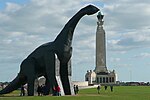HMLCT 7074

HM LCT 7074 is the last surviving Landing Craft, Tank (LCT) in the UK. LCT 7074 is an amphibious assault ship for landing tanks, other vehicles and troops on beachheads. Built in 1944 by Hawthorn Leslie and Company, Hebburn, the Mark 3 LCT 7074 was part of the 17th LCT Flotilla during Operation Neptune in June 1944. LCT 7074 was decommissioned in 1947, and used by the Master Mariners' Club of Liverpool as their club ship Landfall. She served as a floating nightclub in the 60s and 70s and was acquired by the Warship Preservation Trust in the late 1990s. She was moored at Birkenhead for restoration but the Trust went into liquidation and she later sank in the dock. The vessel was raised by the National Museum of the Royal Navy in October 2014 and transported by sea to Portsmouth for restoration.
Excerpt from the Wikipedia article HMLCT 7074 (License: CC BY-SA 3.0, Authors, Images).HMLCT 7074
Clarence Esplanade, Portsmouth Old Portsmouth
Geographical coordinates (GPS) Address Nearby Places Show on map
Geographical coordinates (GPS)
| Latitude | Longitude |
|---|---|
| N 50.78014 ° | E -1.090753 ° |
Address
Landing Craft LCT 7074
Clarence Esplanade
PO5 3AE Portsmouth, Old Portsmouth
England, United Kingdom
Open on Google Maps










